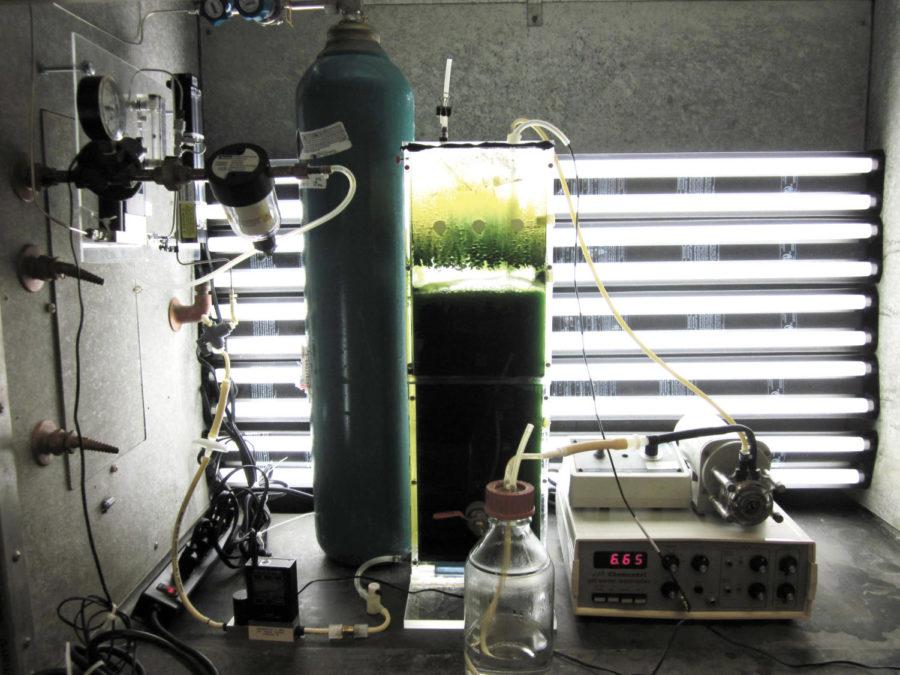ISU researchers grow algae in poultry houses
Chicken Coop Algae
December 7, 2012
The microorganism that colors ponds and lakes green could become an important partner in the future of poultry operations through a project conducted by ISU researchers.
Poultry manure generates ammonia, which Hongwei Xin, professor of agricultural and biosystems engineering, said presents a challenge concerning the health and safety of the animals and workers.
“When ammonia exceeds levels of 25 parts per million or higher … [the gas] begins to cause respiratory health issues,” Xin said. “[Ammonia] is an irritant and has a sharp, pungent odor. When inhaled, the eyes will water and [the gas] could burn the eyes of animals and humans.”
Juhyon Kang, graduate research assistant in food science and human nutrition, said the exhaust air exiting the buildings could also have a negative impact on the environment. Xin said if ammonia gets into the atmosphere, the gas could fall back to the ecosystem in the form of acid rain, which could cause algae outgrowth in ponds and lakes, a problem known as eutrophication.
In order to limit the ammonia released from poultry operations and prevent algae growth in unwanted areas, a project team including Kang and Xin works together to design and develop a bioreactor that will filter ammonia out of the exhaust air in poultry houses while utilizing the gas to grow algae into a useful product in a controlled environment.
“We want to improve the environmental stewardship of the poultry operation,” Xin said. “It would be a perfect match if we could remove ammonia from the exhaust air in poultry houses and use it to grow algae.”
The cultivated algae could provide a source of biomass for biofuel production, as well as an additive for animal feed. Kang said an algal bioreactor is also beneficial for the environment because it filters potentially harmful gases, such as ammonia and carbon dioxide from air exhaust exiting the poultry houses.
“[Our] tests have shown that up to 96 percent of the ammonia is removed from the [air] exhaust,” Kang said.
The algae production operation benefits because the costs associated with algae culture reduce due to a readily available supply of ammonia in the poultry houses. Kang works on the design of the algal bioreactor, which she said is currently a lab scale five-liter working volume bioreactor.
“We’re working to scale this bioreactor up to commercial standards,” Kang said.
Some of the main objectives Xin said the project team is currently researching include finding the best algae growth conditions and analyzing algae in terms of feed composition. Right now, the project team is really looking at the proof of concept by exploring the optimum amounts of ammonia concentration in the environment to grow algae, Xin said.
Aside from ammonia, poultry houses contain other gases, such as carbon dioxide and small amounts of methane that could affect algae growth.
“We will measure the effects of other gases to the microalgaes and differentiate the temperatures, light intensity and other [algae] growth conditions,” Kang said.
While Kang and Xin work on the design and development of the bioreactor, Tong Wang, professor in food science and human nutrition, researches different methods to extract and process the algal cells.
“My approach is to extract the valuable components out during the algae culture process,” said Wang.
For this particular project, Wang said the project team wants to recover the algae through a process that uses a solvent — in this case, alcohol — to cause the algal cells to clump together or flock, called flocculation. Wang said this process will turn the cells into a paste which can then be added directly into animal feed.
“Hens need omega three fatty acids for their eggs,” Wang said. “If you mix [the algae paste] into the feed and feed it to hens, you can produce an egg that has added value.”
Wang said algae research originally began for its potential as a feedstock for biofuel production. As research progressed, Wang said alternative uses for algae, such as additives for animal feed and use ammonia gas removal, were explored that help make algae production economically viable.
“Algae can serve as a feedstock for biorenewable energy or [an additive] for animal feed,” Xin said. “It’s a win-win situation; you kill two birds with one stone.”

















